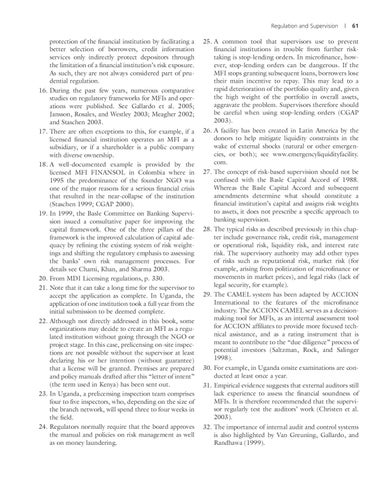Regulation and Supervision
protection of the financial institution by facilitating a better selection of borrowers, credit information services only indirectly protect depositors through the limitation of a financial institution’s risk exposure. As such, they are not always considered part of prudential regulation. 16. During the past few years, numerous comparative studies on regulatory frameworks for MFIs and operations were published. See Gallardo et al. 2005; Jansson, Rosales, and Westley 2003; Meagher 2002; and Staschen 2003. 17. There are often exceptions to this, for example, if a licensed financial institution operates an MFI as a subsidiary, or if a shareholder is a public company with diverse ownership. 18. A well-documented example is provided by the licensed MFI FINANSOL in Colombia where in 1995 the predominance of the founder NGO was one of the major reasons for a serious financial crisis that resulted in the near-collapse of the institution (Staschen 1999; CGAP 2000). 19. In 1999, the Basle Committee on Banking Supervision issued a consultative paper for improving the capital framework. One of the three pillars of the framework is the improved calculation of capital adequacy by refining the existing system of risk weightings and shifting the regulatory emphasis to assessing the banks’ own risk management processes. For details see Chami, Khan, and Sharma 2003. 20. From MDI Licensing regulations, p. 330. 21. Note that it can take a long time for the supervisor to accept the application as complete. In Uganda, the application of one institution took a full year from the initial submission to be deemed complete. 22. Although not directly addressed in this book, some organizations may decide to create an MFI as a regulated institution without going through the NGO or project stage. In this case, prelicensing on-site inspections are not possible without the supervisor at least declaring his or her intention (without guarantee) that a license will be granted. Premises are prepared and policy manuals drafted after this “letter of intent” (the term used in Kenya) has been sent out. 23. In Uganda, a prelicensing inspection team comprises four to five inspectors, who, depending on the size of the branch network, will spend three to four weeks in the field. 24. Regulators normally require that the board approves the manual and policies on risk management as well as on money laundering.
|
61
25. A common tool that supervisors use to prevent financial institutions in trouble from further risktaking is stop-lending orders. In microfinance, however, stop-lending orders can be dangerous. If the MFI stops granting subsequent loans, borrowers lose their main incentive to repay. This may lead to a rapid deterioration of the portfolio quality and, given the high weight of the portfolio in overall assets, aggravate the problem. Supervisors therefore should be careful when using stop-lending orders (CGAP 2003). 26. A facility has been created in Latin America by the donors to help mitigate liquidity constraints in the wake of external shocks (natural or other emergencies, or both); see www.emergencyliquidityfacility. com. 27. The concept of risk-based supervision should not be confused with the Basle Capital Accord of 1988. Whereas the Basle Capital Accord and subsequent amendments determine what should constitute a financial institution’s capital and assigns risk weights to assets, it does not prescribe a specific approach to banking supervision. 28. The typical risks as described previously in this chapter include governance risk, credit risk, management or operational risk, liquidity risk, and interest rate risk. The supervisory authority may add other types of risks such as reputational risk, market risk (for example, arising from politization of microfinance or movements in market prices), and legal risks (lack of legal security, for example). 29. The CAMEL system has been adapted by ACCION International to the features of the microfinance industry. The ACCION CAMEL serves as a decisionmaking tool for MFIs, as an internal assessment tool for ACCION affiliates to provide more focused technical assistance, and as a rating instrument that is meant to contribute to the “due diligence” process of potential investors (Saltzman, Rock, and Salinger 1998). 30. For example, in Uganda onsite examinations are conducted at least once a year. 31. Empirical evidence suggests that external auditors still lack experience to assess the financial soundness of MFIs. It is therefore recommended that the supervisor regularly test the auditors’ work (Christen et al. 2003). 32. The importance of internal audit and control systems is also highlighted by Van Greuning, Gallardo, and Randhawa (1999).
